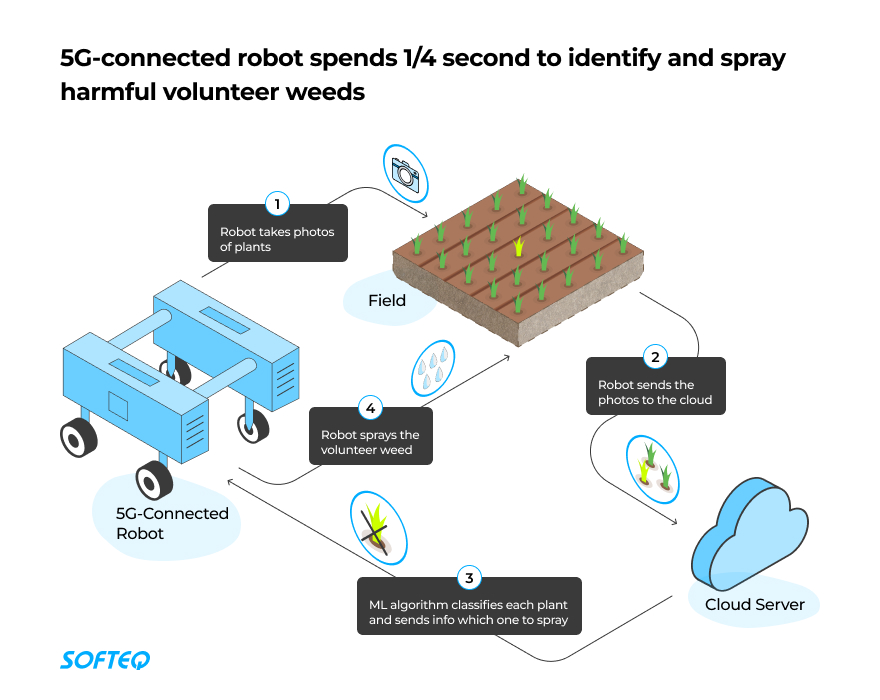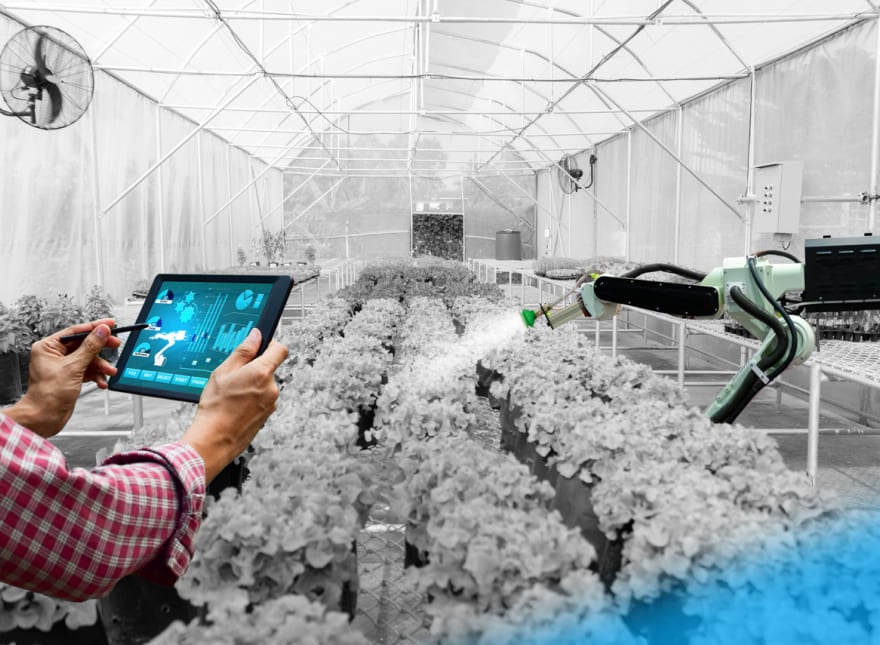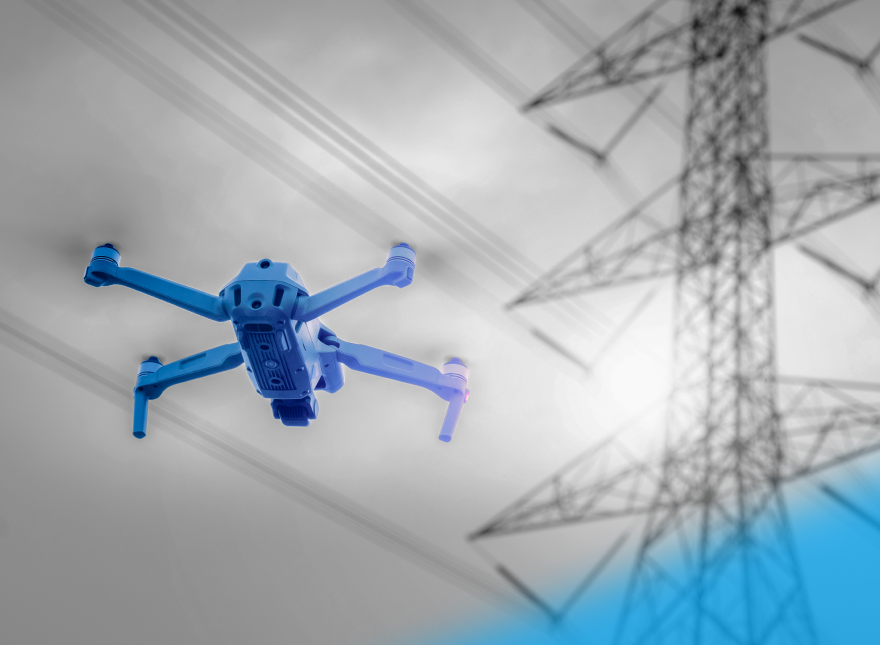Check out our latest blog article: From component to enterprise – modular robotics done right.
5G-Powered Smart Farming Use Cases

Using farm IoT sensors in agriculture is nothing new, but they are just nerves, not the brain. Once you control irrigation, measure soil parameters, monitor crops, or track livestock, it’s all IoT farming. But if you want to solve crop or livestock problems rather than just detect them, you need to add AI algorithms and robotics so the system operates in real time. Here’s where 5G comes into play.
The number of companies currently using 5G for IoT in agriculture is not that high, but the process has already begun. For example, in 2020, the Federal Communications Commission allocated $9 billion for 5G development in rural America. The transition to 5G farming is just a matter of time. So let’s consider the value of 5G for farming and its use cases from the pioneers.
Why 5G Farming? Isn’t LTE Enough?
Let’s say the farmer owns 30,000 cows and wants to know which one is going to calve shortly. This information can be easily obtained from special sensors attached to cows. 3G/4G connectivity would usually allow sensor data from the entire farm to be uploaded by the end of the day. In contrast, 5G can support a larger number of connected farm IoT devices in real time. So the farmer will instantaneously receive the important information they need about each cow.
By having a network that can handle hundreds or thousands of IoT connections without fear of congestion, the data coming off sensors could be used in a more real-time fashion.
5G isn’t just more powerful. It’s also a more flexible standard. It can better adapt to the variety of smart IoT farming connection needs. One of the main advantages is the 5G New Radio standard—an air interface that came after the LTE network 4G standard. It combines productivity and energy efficiency while ensuring higher bandwidth and a more reliable connection. For example, it can enable you to stream HD video from drones flying over fields without disruptions.
The second advantage versus LTE is a new inactive mode (in addition to idle and connected), which allows devices to reconnect faster after being paused. This mode makes the device more responsive and uses fewer resources to restart its work. This could be helpful when you need to promptly detect livestock leaving a designated area, for example.
Let’s have a look at four smart farming examples showcasing how 5G implementation helped agricultural businesses grow.
Use Case 1. Crop Monitoring
Crop waste is one of the factors that contribute to the accumulation of 1 billion tons of annual agricultural waste. With 5G, you can help farmers better manage their resources and reduce waste. IoT farming sensors on plants, in the soil, or on autonomous drones gather valuable data. They help define the exact amount of seeds, fertilizer, water, and pesticides needed. The data gathered can also determine when the farmer should intervene. Autonomous, real-time monitoring like this is becoming a basic feature of IoT farming.
Real-Life Example: Monitoring Plants with Drones
AeroFarms is a US vertical farming company. They operate fully-connected smart vertical farms that produce crops all year round. Since its formation, AeroFarms has been relying on IoT in smart farming. Their recent development plans involve scaling the business and entering new regions, including Danville, Virginia and Abu Dhabi, UAE.
To control new areas remotely, the company has teamed up with a Nokia Bells Lab, a 5G technology provider. This has allowed AeroFarms to use drones and AI algorithms to monitor their crops in real time. Drones inspect vertical farms and snap detailed photographs of each plant. This data is then sent for cloud processing using a 5G connection.
When I watch the drones autonomously imaging our plants, I am blown away by how this truly represents the power to grow the best plants possible.
David Rosenberg, CEO at AeroFarms
To sort out high-resolution images, the company uses computer vision. It is able to analyze plant leaf size, stem length, coloration, curvature, spotting, and tearing. If the ML algorithm detects a problem, the company’s technician receives an alert signal.
The 5G upgrade helped AeroFarms take a new step toward digital transformation. Compared to traditional farming, their platform is much more effective and sustainable. Annually, it provides up to 390 times greater productivity per square foot. At the same time, it uses up to 95% less water and zero pesticides. Their state-of-the-art IoT farming ecosystem helps produce more crops while saving human and natural resources at their farms.
Benefits of Transitioning to 5G Farming
- Reaching 390 times greater productivity versus traditional farming
- Reduced water use by up to 95%
- Scaling the smart farming IoT system to all the company’s vertical farms, including new areas

Use Case 2. Field Weed Control
Weeds and crops are natural companions. One weed variety is a “volunteer” plant, which grows on its own rather than being intentionally planted by a farmer. There are two ways to get rid of volunteers: spraying pesticides and human labor. Pesticides can be harmful to both human health and soil, while human labor is expensive and time-consuming.
Bringing 5G to a farm helps automate weed removal. With a 5G connection, you can put computer vision in place to identify weeds automatically and robots to deal with the leftover plant material.
Real-Life Example: Eliminating Weeds with Autonomous 5G Robots
Agrointelli is a Danish company that develops autonomous robots for farms. One of the ways to use these robots is to fight volunteer potatoes that spoil sugar beet crops. Potato leftovers grow more quickly and block the sunlight from reaching the sugar beets. This prevents sugar beets from growing normally as they can’t absorb enough nutrients.
The 5G-connected robot is equipped with cameras and precision sprayers. It takes photos of plants and sends them to a cloud-based server. The ML algorithm compares these photos with over 6,000 images of weeds and potato plants. After classifying each image, the server sends them back to the robot. If the plant is a potato, the robot sprays it with glyphosate.
The full cycle takes approximately 250 milliseconds. This is possible due to the high-speed 5G connection supported on the farm.

Manually spraying volunteer potato tubers takes, on average, 20 hours per hectare and costs roughly €320–480. It takes a robot around three hours to process one hectare, with up to 95% of volunteer weeds identified. Agrointelli’s smart farming IoT solution helps farmers automate the process and reduce costs, providing 24/7 work if necessary.
Benefits of Transitioning to 5G Farming
- Crop processing is seven times faster
- Weed identification is 95% successful
Use Case 3. Livestock Management
Tracking animals’ real-time movement and behavior is crucial for farmers. Switching to 5G allows farmers to track cows’ fertility. Sensors on tags and collars track cows’ health indicators in real time and determine when they are in heat. With a 5G connection, a farmer can get alerts about cows’ pregnancies and due dates right away via a mobile app.
Real-Life Example: Tracking Calving with Motion Sensors
MooCall is an Irish farmer-based agritech startup that produces IoT devices for farming—cow sensors in particular. They help farms solve the problem of high cow mortality rates from calving.
The Moocall calving device attaches to a cow’s tail and tracks her contractions. The embedded motion sensors measure specific tail movements, and the device alerts the farmer when the cow is about to give birth.
According to the company, around 110,000 calves and 50,000 cows die every year in the UK because of calving issues. This Moocall sensor reduces the number of fatal births by half. It also helps farmers save up to four hours per day per cow during a calving season.
Benefits of Transitioning to 5G Farming
- Moocall sensors reduce calving mortality by up to 50%
- Each device saves four hours daily during the calving season
Use Case 4. Insect Farming
Many companies in the agriculture industry use soy-based products to feed animals. Since soy production is cheap, its cultivation is expanding. But expanding soy production, as with any other monoculture, can be harmful to the environment. For example, in South America, it threatens rainforests as they are being cleared to make way for soy plantations.
One of the alternatives to plants as animal feed is insects. Scaling insect-based food production doesn’t have to harm the environment. Smart farming technologies are exactly what you need to breed insects faster and cheaper.
Real-Life Example: Breeding Grasshoppers for Hens
SmartBreed is a Swiss agricultural startup that produces IoT-connected breeding boxes. It uses insect IoT farming to decrease the environmental impact of soy planting. The plan is to reduce soy-based hen feed in Swiss agriculture by 10% by 2024.
SmartBreed boxes help farmers grow grasshoppers that serve as feed for hens. Unlike soy, insects are something that hens eat naturally. From a nutritional standpoint, grasshoppers are a more valuable snack. They are fatty and protein-rich, with a higher amino acid profile. Besides, hunting for grasshoppers makes hens move around more, keeping them occupied. All this lets farmers produce more healthy eggs and poultry.
The company founders started with a prototype box that allowed grasshoppers to mature in nine weeks. Then, they added sensors and turned the prototype into an IoT farming device. The connected box creates optimal rearing conditions for insects. It uses sensors to automate breeding by monitoring the temperature, humidity, CO2 values, microclimate, and day–night rhythm. This allows them to reduce the breeding time to three weeks.
We work with rural operations. And since we rely on a stable connection, 5G is an exciting option.
Christoph Bertschi, SmartBreed Co-founder
5G will help SmartBreed cut the growth period to two weeks. It will enable them to use image recognition to measure the size and color of the insects. Then, AI will recognize the grasshoppers’ molting phases and adjust the required parameters. As a result, the 5G upgrade will enable breeding boxes to automatically adapt to insect growth.
Benefits of Transitioning to 5G Farming
- Shortening the grasshopper growth phase by a third
- Reducing harmful soy cultivation
- Helping farmers produce healthier eggs and poultry
Produce More Using Less
Agriculture is highly influenced by environmental factors. With climate change and population growth, the pressure of food demand will constantly increase. “Grow more using less” is the only reliable strategy we have. Using smart farming technologies based on fast and stable 5G connectivity gives us hope.
While there isn’t a vast selection of 5G operators to choose from, selecting an IoT-savvy developer is quite a challenge. Softeq has a 360-degree approach to IoT development. We can help you implement IoT in agriculture with its full-stack expertise. The Softeq team can provide consulting with an early-stage innovation step. This will help you develop more using less.
More articles on the topic






